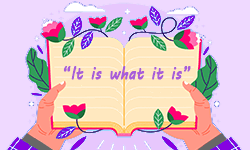
Life is like a rollercoaster full of ups, downs, and unexpected twists. Occasionally, the best way to navigate it all is to simply embrace the unpredictability with a shrug and a smile. The proverb “it is what it is” perfectly captures this attitude and is widely used around the globe. In this article, we will explore how this playful saying helps us roll with life’s punches — because, after all, it is what it is!
Definition: “It is what it is”
The weasel phrase “it is what it is” is used for situations that cannot be changed and, therefore, must be accepted as they are. It suggests resignation to the reality of the circumstances, emphasizing that the situation must be dealt with as it exists rather than as one might wish it to be. The phrase is oftentimes used when further discussion is considered pointless because the facts of the matter are unchangeable.
Below, we have provided some illustrative examples of situations where this proverb might be employed, to elucidate its meaning:
These examples display multiple distinct situations depicting the attitude behind the proverb “it is what it is.” It is often cited as an example of tautology, a rhetorical device where a statement is repeated in different words or where the conclusion is equivalent to the premise. If you’re interested in learning more about this stylistic device to enhance your academic writing, don’t miss out on this article:
Explanation of the visual meaning
The phrase embodies the principle of acceptance, which is a key concept in various psychological approaches, including mindfulness and coping with difficult situations. At the center of the image is a person with a calm and relaxed expression, symbolizing acceptance and resignation. This individual stands as a focal point, representing someone who has come to terms with an unchangeable situation. The background represents a chaotic environment, such as a engaged city street or a turbulent storm. This chaos symbolizes the various uncontrollable or challenging aspects of life that people must sometimes accept. Despite the surrounding turmoil, the serene person remains unaffected, highlighting the essence of the proverb.

How to use it
This proverbial expression can be used in various contexts which involve accepting something that cannot be changed to express acceptance, resignation, or acknowledgment of an unchangeable situation. It is typically said in a humorous way to avoid further discussion, which might be pointless.
Using this phrase in a personal context will not only assist in reducing frustration, but will also help you move forward. In other words, it helps to deal with disappointments as they are and leave what has happened in the past.
In professional contexts, it is oftentimes employed to acknowledge realities that are beyond your control.
This phrase is also used to accept others’ behaviour or characteristics, especially when they are not very likely to change their behaviour. It can be used for friends, family, or even work colleagues to emphasize that a specific characteristic is part of them.
In public discourses or speeches, the phrase can acknowledge uncontrollable situations, fostering a sense of realism.
Use the expression to recognise and accept limitations, whether personal, systematic, or environmental.
Origin and history
The sentiment behind this proverb can be traced back to various philosophical traditions that emphasize acceptance of reality. While the exact phrase may not appear in ancient texts, similar ideas have been expressed by philosophers such as Epictetus and in works of Stoic philosophy, which advocate for accepting things beyond one’s control.
The phrase “it is what it is” has become a common expression in contemporary English, often used to convey acceptance of a situation that cannot be changed. Its origin and history, however, are partially elusive, as it is a colloquial saying that has likely evolved.
Moreover, similar expressions exist in many cultures, typically encapsulating the same idea of resignation or acceptance of reality. For instance, the Spanish say “así es la vida,” which literally translates to “that’s life” and the French like to use “c’est la vie” which can be interpreted as “such is life.”
Initially, it began to appear more frequently in English in the mid-20th century. One of the earliest uses was in a 1949 newspaper article by J. E. Lawrence in the Nebraska State Journal:
“New land is harsh, vigorous, and sturdy. It scorns evidence of frailty. There is nothing of sham or hypocrisy in it. It is what it is, without apology.”
Similar proverbs and synonyms
The proverb has a list of synonyms and similar proverbs that focus on the theme of acceptance and resignation to reality. The list incorporates the following:
- C’est la vie. (French for “such is life”)
- Que sera, sera. (Spanish for “what will be, will be”)
- It’s water under the bridge.
- That’s the way the biscuit crumbles.
- Let bygones be bygones.
- Roll with the punches.
- That’s the way it goes.
- That’s life.
- Such is life.
- What’s done is done.
- You can’t change that.
FAQs
A simple definition of this proverb is accepting the situation and moving forward because the circumstances cannot be changed.
This proverb can be used in various contexts that include accepting the situation as it is and also the fact that it cannot be changed.
Another way of saying “it is what it is” is “that’s life” or “what’s done is done.” You can find similar proverbs in the list in this article.
Yes, this proverb indeed exists in other cultures. Here are some equivalents:
- French: C’est la vie.
- Spanish: Que sera, sera. / Así es la vida.
- Italian: Così è la vita.
- German: So ist das Leben.
- Persian: همینه که هست (Chizi ke hast hamin ast).
- ✓ 3D live preview of your individual configuration
- ✓ Free express delivery for every single purchase
- ✓ Top-notch bindings with customised embossing

